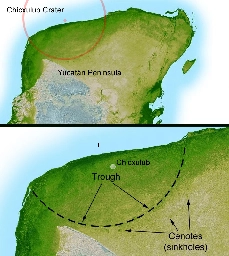Non-invasive imaging approach could lead to innovations in embryo screening.

Breakthrough here is the ability to image embryos comprised of living cells as opposed to post-mortem embryos.
original doi: https://doi.org/10.1016/j.cell.2023.06.003
Babe the goat is trendier than she looks.
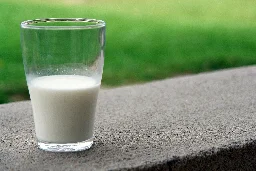
Takeda yanks FDA filing for dengue vaccine, citing data disagreement with regulator
U.S. travelers and healthcare providers looking for another—and potentially safer—dengue vaccine will have to keep waiting. | U.S. travelers and healthcare providers looking for another—and potentially safer—dengue vaccine will have to keep waiting. After a protracted review, Takeda has decided to ...
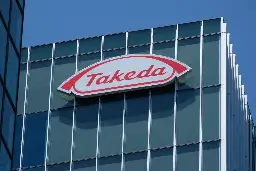
The issue seems to be how the data was collected in the Phase 3 trial:
> Clinical trials of most drugs and vaccines supporting FDA approval are mainly conducted in the U.S. and Europe, where clinical trial protocols are well recognized. The phase 3 TIDES trial used for Qdenga’s application was run in several less well-off, dengue-endemic regions in Latin America and Southeast Asia.
However, it should be noted that Takeda's drug, Qdenga, is already approved by the EMA in the EU and a couple other agencies. It is just the FDA that is holding things up in the US.
Please, please let Ooyama's accidental confession mean something. Imo, this series has really pushed the "do they like me" bit to the breaking point. If Akutsu goes back to questioning it, then it's clear this series is never going to see real relationship progress.
ULA's Vulcan rocket is likely at least a year away from becoming operational.
Continued fallout from the explosion of the Centaur upper stage on ULA's test stand as Vulcan's launch continues to slip.
> In a statement, ULA described the work needed on the Centaur V upper stage as “minor reinforcement at the top of the forward dome,” or the uppermost section of the liquid hydrogen tank. The changes will add strength to the tank, which contains super-flammable fuel chilled to minus 423° Fahrenheit (minus 253° Celsius).
The pressure is on as the DOD is eagerly waiting for Vulcan.
> The US Space Force is eager for the Vulcan rocket to enter service. The Pentagon selected ULA and SpaceX in 2020 to launch around 40 of the military’s most critical surveillance, communications, and navigation satellites from 2022 through 2028. ULA won the rights to launch about 60 percent of the missions, primarily using the new Vulcan rocket, with SpaceX taking the remaining 40 percent with its Falcon rocket family.
Spain delays rocket launch until Sept over risk of starting a wildfire
The maiden flight of Spain's Miura 1 rocket, twice suspended in recent weeks, has now been delayed until September over fears its launch could start a wildfire, its developer said Tuesday.
> "The postponement is motivated by obligatory compliance with the prevention of forest fires... as well as the high temperatures" in southern Spain "to ensure the safety of the area where the launch is carried out".
First time I have seen this cited as a reason for a launch delay.
Dutch and American researchers have used computer simulations to develop a protein that works like an anti-freeze agent. Researchers could use this protein to freeze and defrost biological material such as immune cells, sperm and perhaps even donor organs in the future, without causing any damage to...
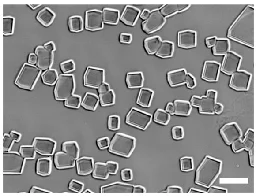
I haven't editorialized the title, but I don't like it since the desired protein structure was thought up by the grad student and the "digitally designed" piece just seems to be some MD modelling to confirm the desired outcome before synthesis.
That being said, I thought this was interesting since freeze/thaw (F/T) stress is ubiquitous in the life sciences and something that is especially important to the emerging field of cell therapy. Typically, excipients like sucrose, trehalose, or glycerol are used to preserve biological molecules during F/T, but they are not protective in every case. Developing alternative means to protect during F/T gives people like me that develop therapeutic formulations more options to turn to in the case of difficult molecules.
doi: https://dx.doi.org/10.1073/pnas.2220380120
With their unique appearance, texture, and mouthfeel, fondants have intrigued bakers and physicists for years. They present an appetizing enigma in the world of confectionery, an intriguing combination of sugar, water, and heat that, when manipulated correctly, yields a delectably creamy product.
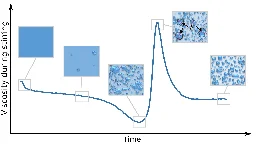
This is about a recent study looking at the rheology of fondant. Essentially, fondant is created from a supersaturated solution of sucrose that is agitated (kneaded). This causes the fondant to experience a sequence of events:
- First, the agitation induces crystal nucleation and growth. In the early stages of crystal formation, the surrounding solution is depleted of sucrose, reducing the bulk viscosity.
- However, as the crystals grow in size, they are large enough to push against one another in hard sphere-like interactions. This causes a sharp increase in viscosity at this critical crystal size.
- As agitation continues, sucrose crystals fracture and the system reaches an equilibrium crystal size distribution, causing the viscosity to decrease from its peak. This is the final state of a smooth, pliable fondant.
There is a doi provided by the article, but as of my posting this, the doi hasn't been activated yet.
Agree that the ending felt a bit weak. I think that picking up the pace in the show a bit more and getting further in the story would have helped things. At the moment, Raeliana is still a character without much agency, and it would be great to see a bit of her future character growth.
So, it has been a while since I read the manhwa (I haven't read the original webnovel), but I am overall pleased with how the adaptation has gone so far. You could definitely tell that there were very limited budgets. There are so many instances of slideshow animations or just still images, but they seemed to invest heavily in making beautiful stills and backgrounds.
My major complaint about the show is that, in general, it has gone very slowly. I expected them to be further along in the story after 12 episodes, but the pacing has been plodding at best. If my memory serves, I think they adapted 3 of the 7 volumes of the manhwa. I understand that a lot of shows tend to go too quickly, but this show just seems to drag out every conversation like it is padding for time (maybe to help stretch the animation budget too).
Overall happy with the show so far and hope that if it gets a second season it gets a bit more resources thrown its way.
That is true. Vertex claims that some of the follow-up therapies to this do not require immunosuppressants, so time will tell.
From a strategic perspective, I wonder if they will proceed with Phase 3 or not. I have worked on several programs in the past where we pushed through to Phase 2 to get a proof of concept in humans before scrapping the program because we have a better version of the molecule (using the same mechanism of action) getting ready right behind it. This therapy from Vertex may have proven the concept to allow a better version to come next.
Vertex could be “leading the path to insulin independence," according to analysts, after another batch of data showed that the off-the-shelf diabetes cell therapy stimulated insulin production in a | Vertex could be “leading the path to insulin independence," according to analysts, after another bat...

This is a summary of a Phase 1/2 trial of a cell therapy meant to stimulate insulin production in diabetes patients. The top line is that it met its clinical endpoints and several of the patients no longer require external insulin dosing at all and their blood sugar is well managed. Vertex also has a number of follow-up therapies in the pipeline meant to improve upon this therapy.
I personally don't have much experience in cell therapy, but the potential of a treatment like this is clear. We will see what the data looks like as this goes through the clinical trial pipeline and expands the patient population in Phase 3.
TIL Chixculub crater was found 70 years prior to being ID'd as the event that killed the dinosaurs
Not sure if TIL-type posts are allowed here, but thought that the story of the history of this event is interesting in a "history of science" type of way. If you want a narrative style of telling, you can check out this Smithsonian piece.
Story time! I watched Jurassic Park again recently and there is a bit in the movie where there is a discussion about competing theories for how the dinosaurs met their end. I didn't realize that back in the early 90's the impact theory was just one of a competing number of theories, so I did some reading.
Turns out that while doing readings to explore for gas/oil in the Caribbean, the Mexican state oil company, Pemex, had found evidence for the Chicxulub crater way back in the 1940's, but dismissed it as volcanic activity and moved on since volcanic regions are not great for oil extraction.
Fast forward to the late 70's and geophysicists are making additional measurements for Pemex and correctly ID the ring structure of these readings as a likely impact crater. The company is not really interested but consent to allow them to present their findings.
The cruel irony is that the conference at which the findings were presented occurred the same week that there was a special, separate conference with impact crater experts to discuss the impact theory of the end of the dinosaurs. So, there were no experts in attendance to learn about Chicxulub crater's existence from the Pemex scientists or recognize it's importance.
It took another 9 years, 1990, before the two worlds connected and further action was taken to ID Chicxulub as the impact crater that corresponded to the exact time period scientists were looking for.
Then, finally, it was 2010 before scientific consensus was (generally) reached that Chicxulub is the impact that ended the dinosaurs.
I love Lichtenberg Figures as much as the next nerd, but knowing even a little bit about how they are made should make all the alarm bells in your head go off that it shouldn't be done at home. If you want a safe way to play around with electricity, get a Van de Graaff generator.
In post-Roe US, clinical trials may be too risky for people who can get pregnant
The bans and restrictions complicate clinical trials and leave risky paper trails.

doi for the original Science piece: https://doi.org/10.1126/science.adh3104
Wild bison that once numbered in the tens of millions in North America before being hunted almost to extinction are once again thriving in a pocket of western Canada.

This summarizes a report from Parks Canada about the reintroduction of bison to the Banff National Park.
> A Parks Canada report published this week concluded that the reintroduction was a success, and it suggested that due to their robust growth rate, this bison subpopulation—one of only five that occupy a mere 0.5 percent of their original range in North America—may no longer be considered endangered within a decade.
Original report: https://parks.canada.ca/pn-np/ab/banff/info/gestion-management/bison/rapport-mai-reintroduction-may-report
This is neither here nor there, but I just want to compliment whoever did their favicon. I didn't realize favicons could be animated like that, I am surprised I don't see it more often.
I commented this in a different thread on this news story, but this approval in an interesting one in that it has been approved using the accelerated approval pathway because there was an unmet clinical need. However, if you look at the clinical landscape, there are other options for treatment (also from Sarepta I should mention). Additionally, the interim clinical data showed protein expression which is what the FDA cited in their approval, however that interim data did not show significant positive clinical benefit. From PBS:
FDA scientists detailed a long list of concerns with the company’s research, particularly a mid-stage study that the company submitted for FDA review. Overall, it failed to show that boys who received the therapy performed significantly better on measures like standing, walking and climbing than those who got a dummy treatment
Accelerated approval pathways make sense in many cases they are used, however, the agency should beware allowing accelerated approval being abused by drugmakers to get a drug to market quickly and then slow-walk the post-approval obligations (which are usually very expensive phase 3 studies). Being too liberal with accelerated approvals incentivizes questionably efficacious therapies that are simply used as a profit tool before the data shows the full extent of their clinical impact.
I recently posted an opinion piece that talks about this in some more detail and provided some additional thoughts in that thread. I am not a specialist when it comes to regulatory practices or strategy, but simply a scientist in the field that is concerned about potential abuse of a regulatory mechanism that has the potential to cause harm to patients.
Plenty of news stories have focused on the danger posed by Kessler syndrome. In this condition, space is made inaccessible by a cloud of debris surrounding our planet that would destroy any further attempts to get into orbit. Therefore, plenty of companies have sprung up that problem to take care of...

This mission, ELSA-M, is a follow-up on the proof of concept ELSA-D mission that was launched in 2021 and successfully rendezvoused with a client's satellite.
A challenge to this company going forward I see is that their interceptor requires a proprietary plate of their design to already have been affixed to the target satellite. I just don't see how this gets wide adoption enough to help meet their lofty preventing Kessler syndrome rhetoric.
The war is far from over but Ukraine’s government is already considering how to build back — and use the opportunity to move on from a Soviet-era system.
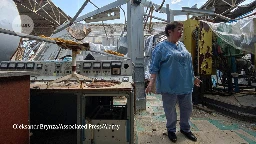
cross-posted from: https://beehaw.org/post/698765
> This article summarizes some of the challenges as well as opportunities that Ukraine is faced with in a post-Russian invasion world. > > In addition to the brain-drain effect of talented scientists leaving the country, Ukraine has some structural issues as well: > > > The current research system is composed largely of the Soviet-style national science academy — for which the research agenda was historically set by state officials — and a university sector in which research is funded by the science ministry. > > > Entirely lacking is a modern, performance-based grant-giving system...the centrepiece of a new system would include funding streams for basic research, competitive grants and defence-related projects. Ukraine’s research strengths include agricultural technology, energy and planetary science > > doi: https://doi.org/10.1038/d41586-023-02031-8
Octopus-inspired drug delivery patch
cross-posted from: https://beehaw.org/post/698268
> This paper details a new hydrogel patch coated in microneedles used to delivery medication to tissues. The design of the patch was inspired by the Blue-ringed octopus and the method by which it administers toxins. > > Unrelated to this paper (which is really cool) I feel like scientific figures have really fallen prey to a trend to cram too much information into each figure, making them impossible to comprehend. This paper as an example features two figures that go all the way from A through L. If you have to use almost half the alphabet to label your figures, maybe something can go to supplemental information. > > doi: https://doi.org/10.1126/sciadv.adh2213
Octopus-inspired drug delivery patch
This paper details a new hydrogel patch coated in microneedles used to delivery medication to tissues. The design of the patch was inspired by the Blue-ringed octopus and the method by which it administers toxins.
Unrelated to this paper (which is really cool) I feel like scientific figures have really fallen prey to a trend to cram too much information into each figure, making them impossible to comprehend. This paper as an example features two figures that go all the way from A through L. If you have to use almost half the alphabet to label your figures, maybe something can go to supplemental information.
doi: https://doi.org/10.1126/sciadv.adh2213
The lack of registration of medicines in Kenya, Tanzania and Uganda is limiting access to safe, effective, and affordable essential medicines, according to a new analysis from Newcastle University in the UK and Makerere University in Uganda, published by the Journal of the Royal Society of Medicine.

This analysis examines the lack of availability of medications within several African nations. One of the primary drivers of medicine availability is the lack of marketing authorization for existing products with these nations regulatory bodies. Instead the study finds that drugmakers have been over-applying for less medically critical medicines, slowing down the process due to a lack of regulatory agency bandwidth.
doi: https://dx.doi.org/10.1177/01410768231181263
Evidence is mounting that astronauts are more susceptible to infections while in space. For example, astronauts on board the International Space Station (ISS) commonly suffer from skin rashes, as well as respiratory and non-respiratory diseases. Astronauts are also known to shed more live virus part...

cross-posted from: https://beehaw.org/post/697648
> Exposure to microgravity causes changes to the human immune system: > > > "Here we show that the expression of many genes related to immune functions rapidly decreases when astronauts reach space, while the opposite happens when they return to Earth after six months aboard the ISS," said Dr. Odette Laneuville, an associate professor at the Department of Biology of the University of Ottawa, leading author of a new study in Frontiers in Immunology. > > doi: https://dx.doi.org/10.3389/fimmu.2023.1171103
Evidence is mounting that astronauts are more susceptible to infections while in space. For example, astronauts on board the International Space Station (ISS) commonly suffer from skin rashes, as well as respiratory and non-respiratory diseases. Astronauts are also known to shed more live virus part...

Exposure to microgravity causes changes to the human immune system:
> "Here we show that the expression of many genes related to immune functions rapidly decreases when astronauts reach space, while the opposite happens when they return to Earth after six months aboard the ISS," said Dr. Odette Laneuville, an associate professor at the Department of Biology of the University of Ottawa, leading author of a new study in Frontiers in Immunology.
doi: https://dx.doi.org/10.3389/fimmu.2023.1171103
Great article summarizing the BBB. The brain is one of the highest priority targets for biologics therapeutics (viral & non-viral gene therapies, antibodies, peptides, etc.) and one of the most difficult to access via traditional routes of administration (IV, subcutaneous). I have worked on programs in the past that tried to access the brain via other administration methods (intrathecal, intraparenchymal), but both of these are quite invasive and lead to adverse events purely from the procedure. Engineering ways to cross the BBB would open up a huge number of potential therapeutic options for neurological disorders.
One of the other high priority targets that is difficult to access is the eye/retina. It has a similar set of biological barriers that prevent access to sensitive areas that are medically desired. If you want more reading on the eye, see this paper.
Using data from the Spitzer space observatory, Dr. Susana Iglesias-Groth, a researcher from The Instituto de Astrofísica de Canarias (IAC), has found evidence for the existence of the amino acid tryptophan in the interstellar material in a nearby star-forming region. The research is published in Mon...
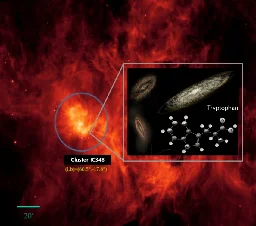
cross-posted from: https://beehaw.org/post/659341
> This article summarizes findings showing that the Spitzer telescope has observed the spectral signature of tryptophan in an extrasolar system. > > This isn't the first instance of amino acids found extra-terrestrially (previously found on asteroids), but is the first found outside our solar system. Tryptophan has a very strong and very clear spectral signature (it is ubiquitously used in life sciences for example). > > doi: https://dx.doi.org/10.1093/mnras/stad1535
Using data from the Spitzer space observatory, Dr. Susana Iglesias-Groth, a researcher from The Instituto de Astrofísica de Canarias (IAC), has found evidence for the existence of the amino acid tryptophan in the interstellar material in a nearby star-forming region. The research is published in Mon...
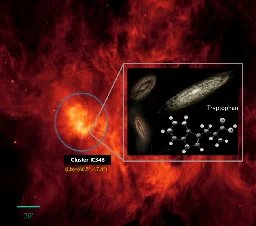
This article summarizes findings showing that the Spitzer telescope has observed the spectral signature of tryptophan in an extrasolar system.
This isn't the first instance of amino acids found extra-terrestrially (previously found on asteroids), but is the first found outside our solar system. Tryptophan has a very strong and very clear spectral signature (it is ubiquitously used in life sciences for example).
doi: https://dx.doi.org/10.1093/mnras/stad1535
I think that fMRI is just beginning to realize its potential. It is such a powerful technique to image the brain, that as we improve the technique and can see more, we will learn more. I like to make the analogy that modern imaging techniques (MRI, microscopy, PET, etc.) have done at least as much to expand human knowledge as the more widely known (within the general public) telescopes (Hubble, JWST, etc.).
One thing that I like about this approach is that it is looking at the brain as a complex system rather than trying to ID and characterize individual neurons. From the article:
Neuroscience has traditionally focused on interactions between neurons to understand brain function. There is a growing area of science looking at larger processes within the brain to help us understand its mysteries.
This reminds me of my statistical mechanics course when I was in grad school. You can study individual particles all you want, but when you get a large number of them, things change. One oxygen molecule behaves differently than a room full of air just like a single neuron behaves differently than a head filled with a brain. The path of neuroscience is following a similar trajectory physics did in that it could make sense of things at the individual scale, but working with large numbers of interactions is harder and requires more complex experiments/theories/models to deal with.
In my professional life, I have worked on a number of clinical phase therapeutics and authored sections of regulatory filings submitted to agencies like the FDA and EMA. Several of those assets were classified as orphan drugs and were granted accelerated approval. I think that the accelerated approval process fulfills a role that is needed in cases where there is an unmet medical need. Additionally, some indications lend themselves to proven proxy measures for efficacy that give a high level of confidence in clinical use. However, the accelerated approval process as it is currently used is prone to abuse in that the FDA is not able or willing (not sure which) to enforce post-approval actions on drugmakers in a timely fashion.
The author's example of Makena shows that over a decade can pass without showing medical efficacy in follow-up trials before marketing authorization is pulled. The author doesn't go into detail, merely linked to it, but the conditional approval granted by the EMA is much more fit for purpose. Under that process, the conditional approval is just granted for one year and must be renewed each year. I have not worked on this renewal process personally, but from experience interacting with the agencies before, they would be looking for material progress towards meeting any stated post-approval obligations. This process gives the EMA an annual chance to pull a product if there is ambiguous or no demonstrated clinical effect or if the adverse events are more severe or common than anticipated.
As an aside, I found it interesting that the impending Leqembi (lecanemab) accelerated approval is what inspired this article. Leqembi's predecessor, Aduhelm (aducanumab), was granted accelerated approval, but was so poorly received by the market/hcp's/insurance companies, that it might as well have not been approved at all.
Thank you! If I am understanding right, I think my guess was pretty bang on. Fig. 3b shows the energy dissipation from the center of the vortex blob moving outward and shows a steep drop off past where they define their edge (brown line).
Also, thank you so much for the extension recommendation! I have journal access through work for journals I go to frequently, so I forget about arxiv sometimes.
I am not in academia any longer, so I don't have access to the full paper, but I would be really curious about the boundary conditions they see. They claim to have a region of isolated turbulent mixing, however, this would mean that they no longer have a no-slip boundary layer, something that I find hard to believe in a fully fluid system like this. Instead, I imagine the best they could likely do is have a boundary region over which the Reynolds number decreases rapidly as you move from the turbulent region to the non-turbulent region.
As an aside, this reminds me of some really cool research that a friend of mine did back in grad school which is kind of like the inverse of this. They created an active system in which turbulent mixing was bound to the surface of a vesicle (video)
Not too much is really calling out to me for Summer, so I will likely get a chance to work through some backlog. There are a couple I will check out:
- Most looking forward to: Horimiya
- Most hopeful it turns out well: Kenshin remake
- Most curious to see what the hype is about: Atelier Ryza
- Most willing to turn brain off and just enjoy: Vending Machine Isekai
As an anime-only I have absolutely loved this series. I managed to go in completely blind and have been blown away. I am fully prepared to binge the manga as soon as this season is over.
Great insight into the clinical process of Alzheimers care. I have worked on Amyloid programs before (early stage pharma R&D), and was wondering if there are significant clinical differences between lecanemab and aducanumab that makes you think this approval will have a less problematic trajectory? From my perspective, they are both mAbs targeting the same thing, but the discussion around lecanemab is different than it was for aducanumab, but perhaps that was primarily due to the non-standard phase 3 process of adu.
I have my PhD in physics with a background in material science and primarily work in Pharma developing early stage biologics programs (antibodies, gene therapies, etc). That means basically any of the molecules I have worked on are maybe 5+ years away from reaching the market. I don't meet many other physicists in this field, instead it is primarily chemical engineers and biochemists. Even working in industry, I still have the chance to publish and attend conferences though.
